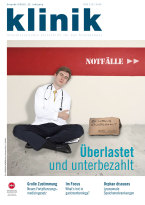Melden Sie sich bitte hier kostenlos und unverbindlich an, um den Inhalt vollständig einzusehen und weitere Services von www.medmedia.at zu nutzen.
Gastrointestinale Onkologie – Bedeutung der Koloskopie zur Kolonkarzinomvorsorge
AutorIn: Philip Jeschek, Elisabeth Waldmann, Monika Ferlitsch • Gastroenterologie • Klinik 06|2014
• 15.12.2014
AutorIn: Dr. Philip Jeschek
Klinische Abteilung für Gastroenterologie und Hepatologie, Universitätsklinik für Innere Medizin III, Medizinische Universität Wien
AutorIn: Dr. Elisabeth Waldmann
Klinische Abteilung für Gastroenterologie und Hepatologie, Universitätsklinik für Innere Medizin III, Medizinische Universität Wien
AutorIn: Univ.-Prof. Dr. Monika Ferlitsch
Klinische Abteilung für Gastroenterologie und Hepatologie, Universitätsklinik für Innere Medizin III, Medizinische Universität Wien
Foto: Felicitas Matern
1 STATISTIK AUSTRIA – Dickdarm, Enddarm. (Zugriff am 17. Oktober 2014)
2 Ferlay J et al., Estimates of worldwide burden of cancer in 2008: GLOBOCAN 2008. Int J Cancer 2010; 127:2893–917
3 Edwards BK et al., Annual report to the nation on the status of cancer, 1975-2006, featuring colorectal cancer trends and impact of interventions (risk factors, screening, and treatment) to reduce future rates. Cancer 2010; 116:544–73
4 Garborg K et al., Current status of screening for colorectal cancer. Ann Oncol 2013; 24:1963–72
5 Sharaf RN, Ladabaum U, Comparative effectiveness and cost-effectiveness of screening colonoscopy vs. sigmoidoscopy and alternative strategies.
Am J Gastroenterol 2013; 108:120–32
Am J Gastroenterol 2013; 108:120–32
6 Samadder NJ et al., 782 Risk of incident colorectal cancer diagnosis after colonoscopy: a population-based study in Utah. Gastroenterology 2014; 146:S132–3
7 Hassan C et al. Post-polypectomy colonoscopy surveillance: European Society of Gastrointestinal Endoscopy (ESGE) Guideline. Endoscopy 2013; 45:842–51
8 Ferlitsch M et al., Sex-specific prevalence of adenomas, advanced adenomas, and colorectal cancer in individuals undergoing screening colonoscopy. JAMA 2011; 306:1352
9 Jeschek P et al., A greater proportion of liver transplant candidates have colorectal neoplasia than in the healthy screening population. Clin Gastroenterol Hepatol 2014 [Epub ahead of print]
10 Whitlock EP et al., Screening for colorectal cancer: A targeted, updated systematic review for the U.S. Preventive Services Task Force. Ann Intern Med 2008; 149:638–58
11 Warren JL et al., Adverse events after outpatient colonoscopy in the Medicare population. Ann Intern Med 2009; 150:849–57
12 Zauber AG et al., Colonoscopic polypectomy and long-term prevention of colorectal-cancer deaths. NEJM 2012; 366:687–96
13 Løberg M et al., Long-term colorectal-cancer mortality after adenoma removal. NEJM 2014; 371:799–807
14 Brenner H, Stock C, Hoffmeister M, Effect of screening sigmoidoscopy and screening colonoscopy on colorectal cancer incidence and mortality: systematic review and meta-analysis of randomised controlled trials and observational studies. BMJ 2014; 348:g2467
15 Holme Ø et al., Effect of flexible sigmoidoscopy screening on colorectal cancer incidence and mortality: a randomized clinical trial. JAMA 2014; 312:606–15
16 Ferlitsch M et al., Sex is a stronger predictor of colorectal adenoma and advanced adenoma than fecal occult blood test. Med Oncol 2014; 31:151
17 Brenner H et al., Prevention, early detection, and overdiagnosis of colorectal cancer within 10 years of screening colonoscopy in Germany. Clin Gastroenterol Hepatol 2014 [Epub ahead of print]
18 Kaminski MF et al., Quality indicators for colonoscopy and the risk of interval cancer. NEJM 2010; 362:1795–803
19 Bannert C et al., Sedation in screening colonoscopy: impact on quality indicators and complications. Am J Gastroenterol 2012; 107:1837–48
20 Waldmann E et al., Endoscopists with low adenoma detection rates benefit from high-definition endoscopy. Surg Endosc 2014 [Epub ahead of print]




